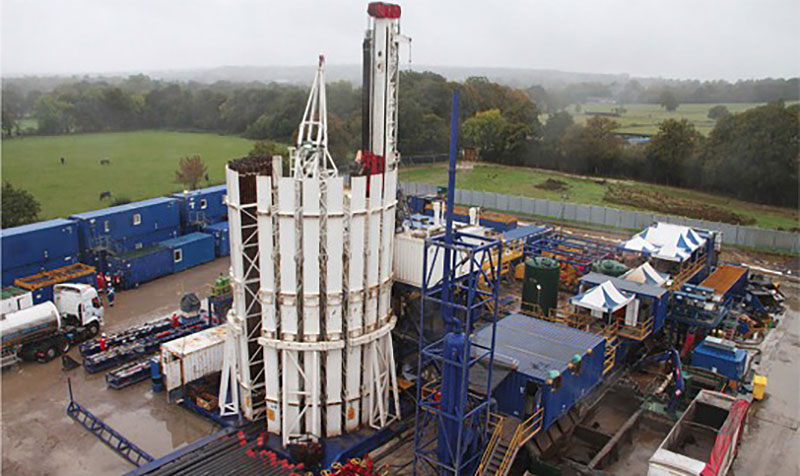
Drilling Rig Leased From Cuadrilla Drilling Horse Hill Exploration Well To A Depth Of 8,860ft In Late 2014 (Click To Enlarge)
Companies like UK Oil & Gas Investments (UKOG) at Horse Hill, or Cuadrilla Resources, IGas Energy, Third Energy, are trying to pioneer an entirely new industry; unconventional fossil fuel extraction in the UK. To see where this is leading, it is necessary to look to other countries where these industries are more advanced (US, Canada and Australia) and to make reasonable extrapolations of what could be expected in the UK. The fundamental feature of unconventional oil and gas, is the much greater levels of extraction effort required due to the impermeability of the rock that it is trapped in. In the the last few years over 55,000 coal bed methane (CBM) wells, 45,000 shale gas wells, 30,000 tight oil wells and tens of thousands of tight gas wells have been drilled in the U.S. alone. Many thousands more can be expected to be drilled if the process is allowed to continue.

Bakken Shale Well Pads (Dots) And Horizontal Wellbores (Lines) In North Dakota Where 10,000 Wells Have Been Drilled (Click To Enlarge)
UK Oil & Gas (UKOG) have bragged that there may be up to 124 billion barrels of “oil in place” in the Weald Basin. Even if this number is correct, oil in place is not the same as oil which can be extracted. For unconventional resources the difference can be very large indeed. For instance, the current recovery factors for the Bakken Shale are estimated at about 3.5 percent. With this assumed recovery factor the notional accessible oil becomes a still improbable 4.3 billion barrels. Given that the total production of a tight oil well is measured in the low hundreds of thousands of barrels (around 125,000 barrels per well) it would require tens of thousands of wells to extract this much oil.
Alternative estimates of the unconventional oil in the Weald come from the British Geological Survey (BGS) and the US Energy Information Administration (EIA). The BGS give the lowest estimate of 4.4 billion barrels of oil in place. The US Energy Information Administration (EIA) estimate 17 billion barrels of oil in place, 700 million barrels (p19) of which could possibly be extracted. This estimate would require in the region of 4,700 wells to extract. Applying a recovery factor of 3.5% to the BGS estimate suggests that just 154 million barrels could be extracted from the Weald. This would still require over 1,200 wells.
The significance of these estimates is their scale, since UK oil consumption stands at around 1.6 million barrels per day. The BGS estimate of recoverable oil would supply the UK for just 96 days. The EIA’s estimate would last 437 days and even UKOG’s highly dubious 4.3 billion barrels would only lasts 7 years, assuming you managed to drill the 34,000 wells required. Producing even a fraction of this would require several wells to be drilled each and every day, devastating the region with a constantly growing toxic legacy. To give some perspective the conventional oil field at Singleton in West Sussex has produced around 3.7 million barrels of oil to date from 7 wells and might eventually produce up to 10 million barrels. 10 million barrels would supply the UK for just over 6 days.
See Fracking The Weald: The Growing Tight Oil Threat for more information.

